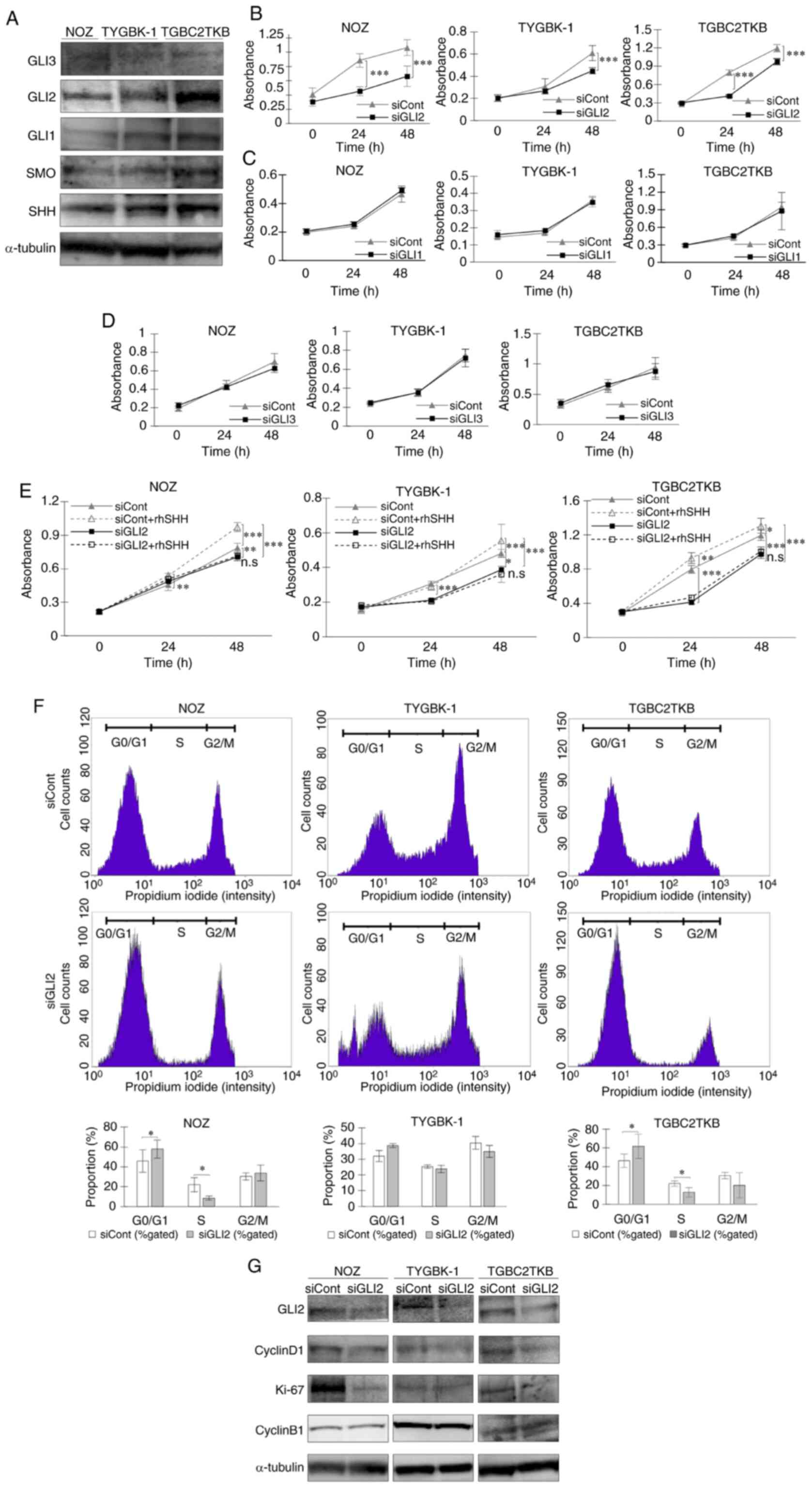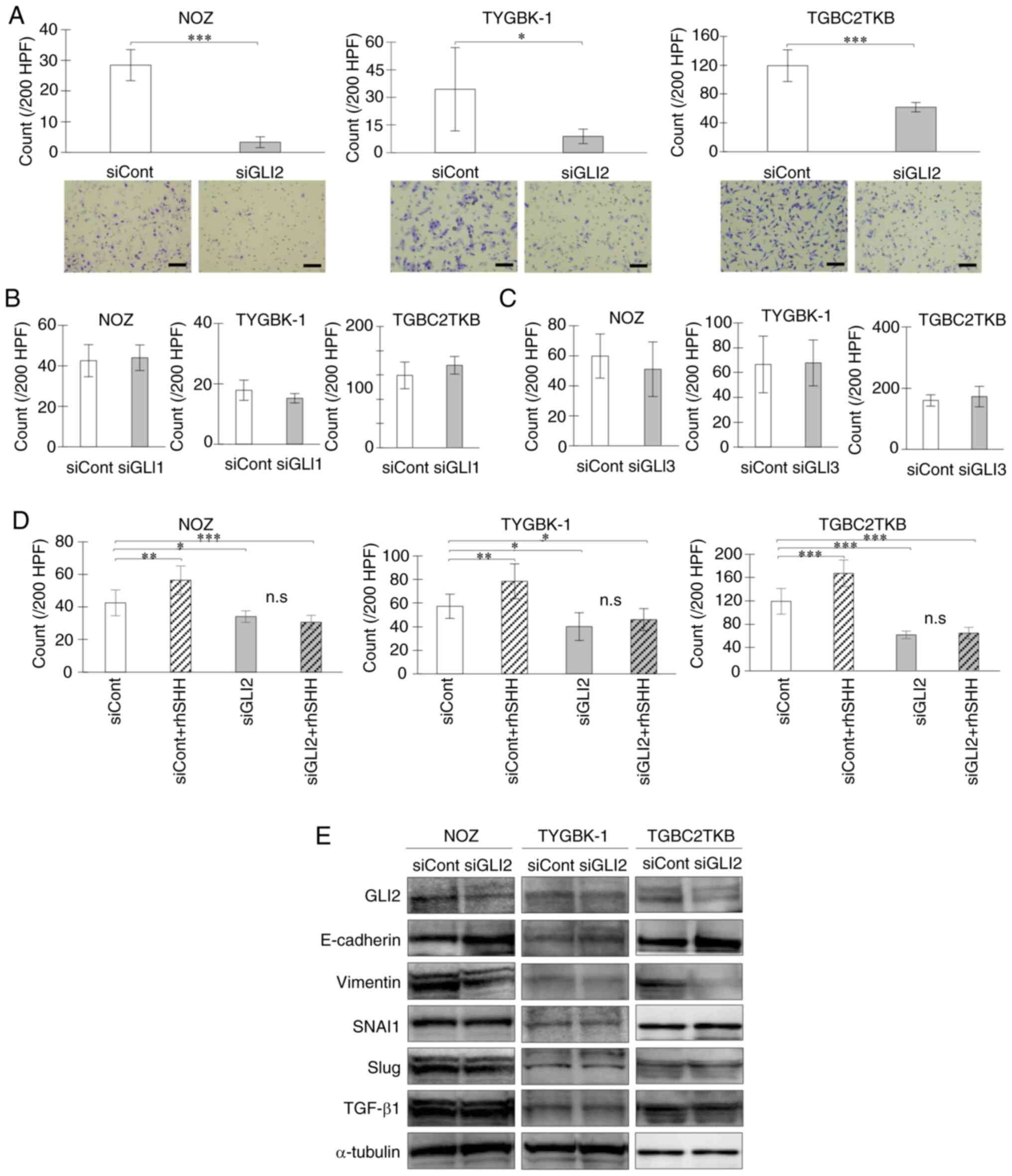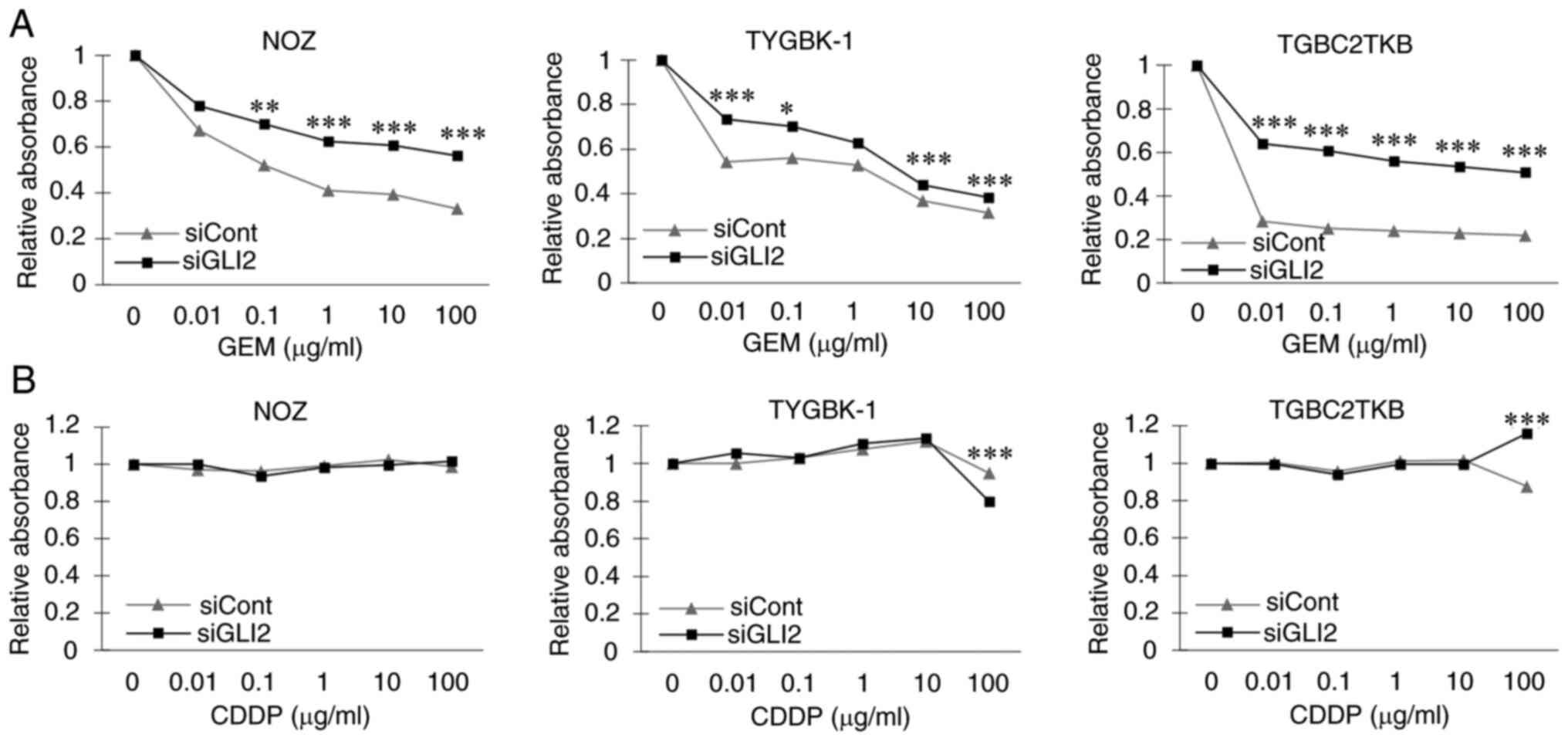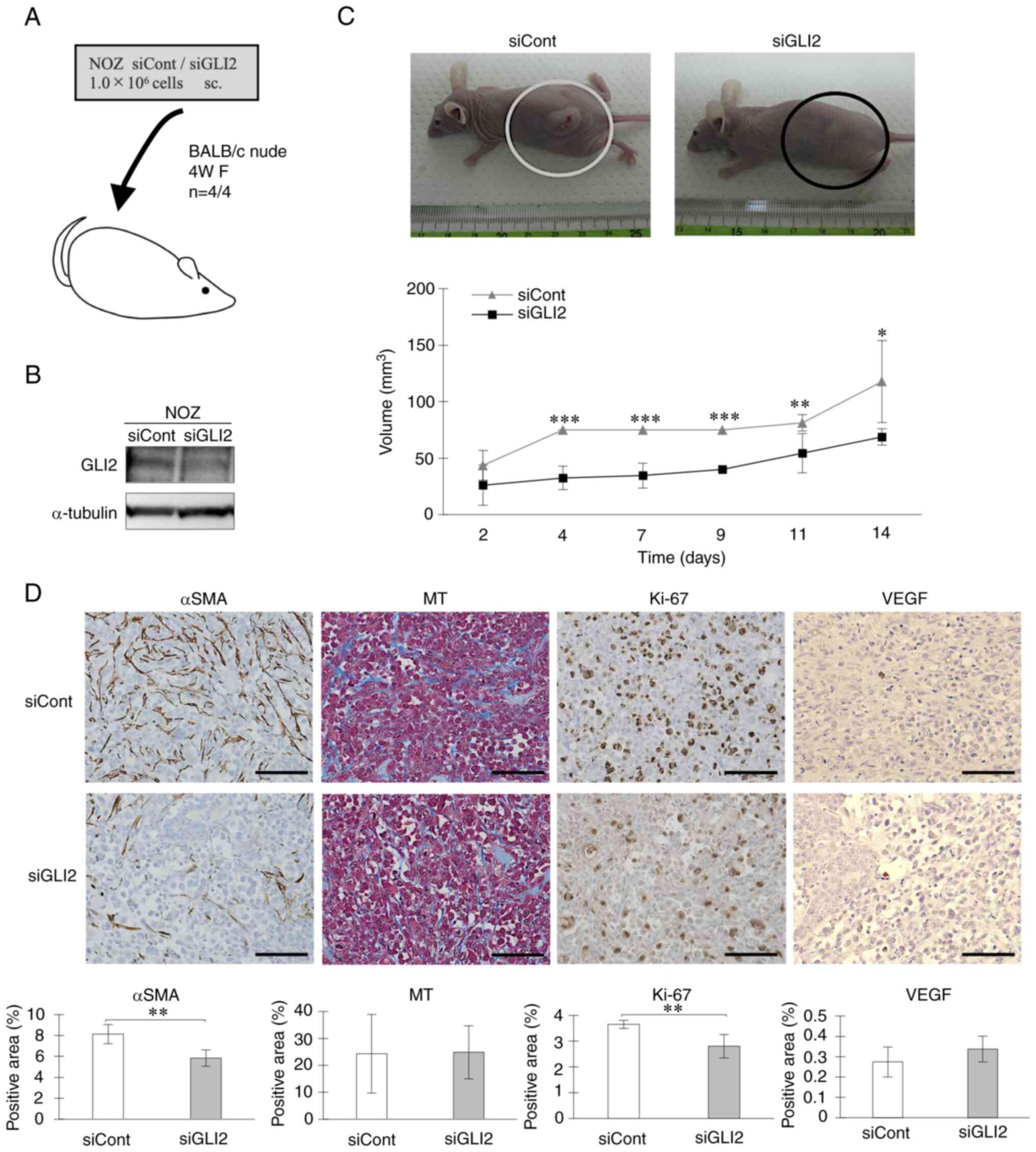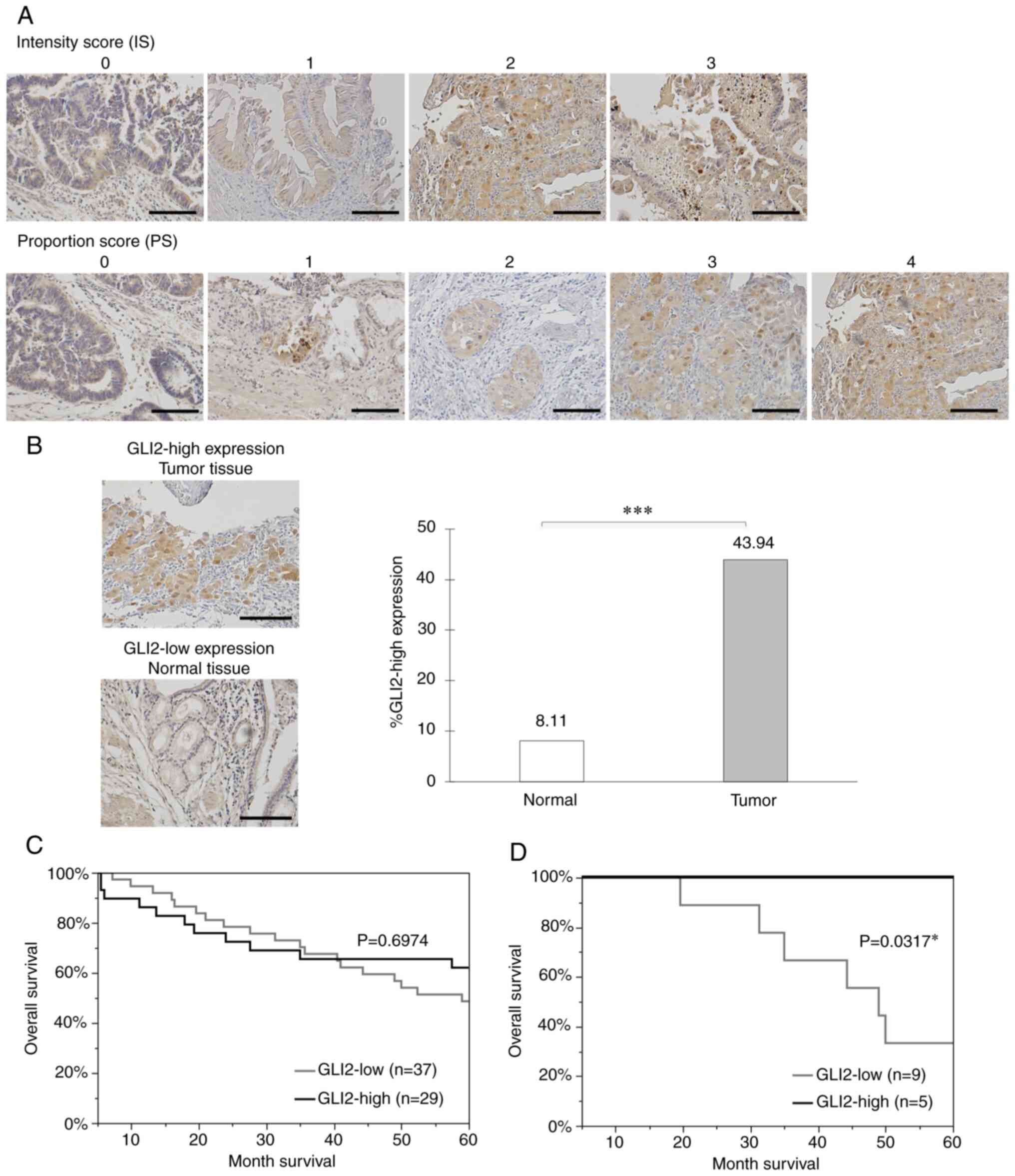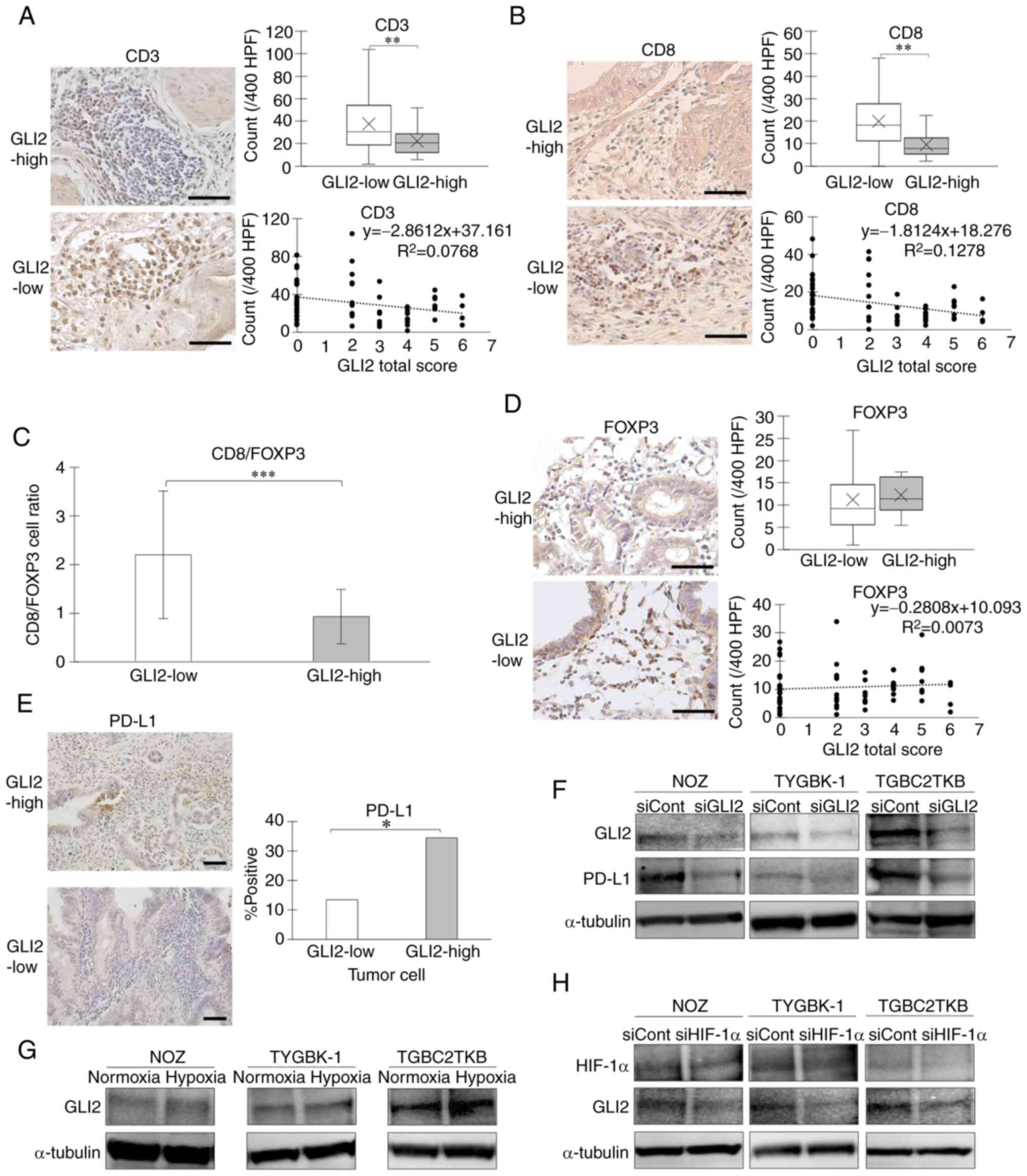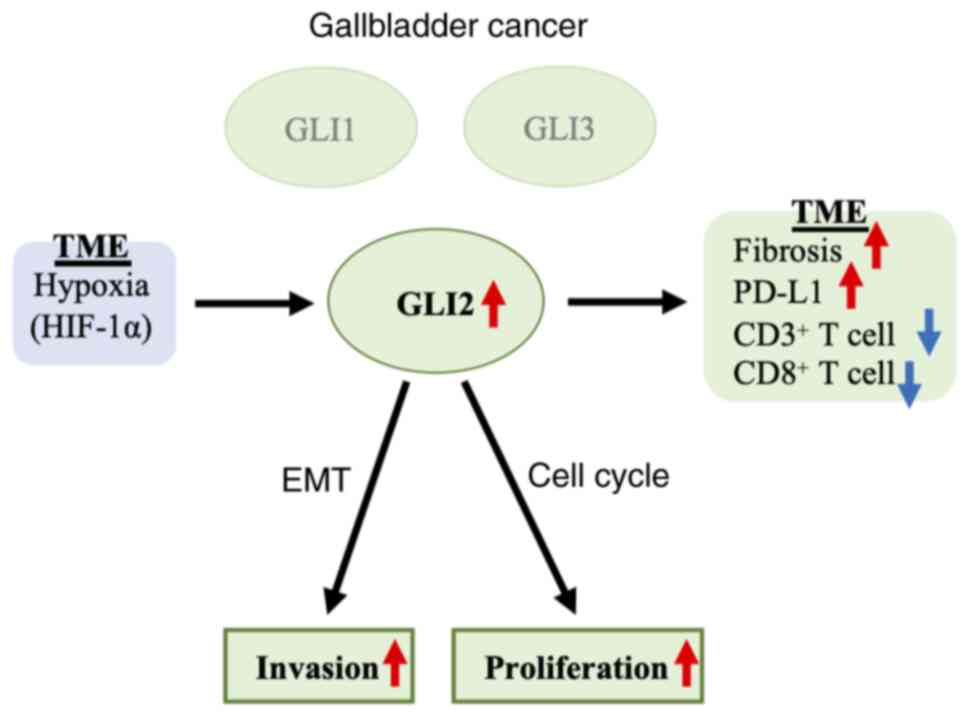|
1
|
Bray F, Ferlay J, Soerjomataram I, Siegel
RL, Torre LA and Jemal A: Global cancer statistics 2018: GLOBOCAN
estimates of incidence and mortality worldwide for 36 cancers in
185 countries. CA Cancer J Clin. 68:394–424. 2018. View Article : Google Scholar : PubMed/NCBI
|
|
2
|
Lazcano-Ponce EC, Miquel JF, Muñoz N,
Herrero R, Ferrecio C, Wistuba II, Alonso de Ruiz P, Aristi Urista
G and Nervi F: Epidemiology and molecular pathology of gallbladder
cancer. CA Cancer J Clin. 51:349–364. 2001. View Article : Google Scholar : PubMed/NCBI
|
|
3
|
Misra S, Chaturvedi A, Misra NC and Sharma
ID: Carcinoma of the gallbladder. Lancet Oncol. 4:167–176. 2003.
View Article : Google Scholar : PubMed/NCBI
|
|
4
|
Hebrok M: Hedgehog signaling in pancreas
development. Mech Dev. 120:45–57. 2003. View Article : Google Scholar : PubMed/NCBI
|
|
5
|
Cohen MM Jr: The hedgehog signaling
network. Am J Med Genet A. 123A:5–28. 2003. View Article : Google Scholar : PubMed/NCBI
|
|
6
|
Ingham PW and McMahon AP: Hedgehog
signaling in animal development: Paradigms and principles. Genes
Dev. 15:3059–3087. 2001. View Article : Google Scholar : PubMed/NCBI
|
|
7
|
Kalderon D: Similarities between the
hedgehog and Wnt signaling pathways. Trends Cell Biol. 12:523–531.
2002. View Article : Google Scholar : PubMed/NCBI
|
|
8
|
Ruel L, Rodriguez R, Gallet A,
Lavenant-Staccini L and Therond PP: Stability and association of
smoothened, costal2 and fused with cubitus interruptus are
regulated by hedgehog. Nat Cell Biol. 5:907–913. 2003. View Article : Google Scholar : PubMed/NCBI
|
|
9
|
Onishi H and Katano M: Hedgehog signaling
pathway as a therapeutic target in various types of cancer. Cancer
Sci. 102:1756–1760. 2011. View Article : Google Scholar : PubMed/NCBI
|
|
10
|
Kinzler KW, Bigner SH, Bigner DD, Trent
JM, Law ML, O'Brien SJ, Wong AJ and Vogelstein B: Identification of
an amplified, highly expressed gene in a human glioma. Science.
236:70–73. 1987. View Article : Google Scholar : PubMed/NCBI
|
|
11
|
Gailani MR and Bale AE: Developmental
genes and cancer: Role of patched in basal cell carcinoma of the
skin. J Natl Cancer Inst. 89:1103–1109. 1997. View Article : Google Scholar : PubMed/NCBI
|
|
12
|
Xie J, Murone M, Luoh SM, Ryan A, Gu Q,
Zhang C, Bonifas JM, Lam CW, Hynes M, Goddard A, et al: Activating
Smoothened mutations in sporadic basal-cell carcinoma. Nature.
391:90–92. 1998. View
Article : Google Scholar : PubMed/NCBI
|
|
13
|
Hahn H, Wicking C, Zaphiropoulous PG,
Gailani MR, Shanley S, Chidambaram A, Vorechovsky I, Holmberg E,
Unden AB, Gillies S, et al: Mutations of the human homolog of
Drosophila patched in the nevoid basal cell carcinoma syndrome.
Cell. 85:841–851. 1996. View Article : Google Scholar : PubMed/NCBI
|
|
14
|
Johnson RL, Rothman AL, Xie J, Goodrich
LV, Bare JW, Bonifas JM, Quinn AG, Myers RM, Cox DR, Epstein EH Jr
and Scott MP: Human homolog of patched, a candidate gene for the
basal cell nevus syndrome. Science. 272:1668–1671. 1996. View Article : Google Scholar : PubMed/NCBI
|
|
15
|
Kubo M, Nakamura M, Tasaki A, Yamanaka N,
Nakashima H, Nomura M, Kuroki S and Katano M: Hedgehog signaling
pathway is a new therapeutic target for patients with breast
cancer. Cancer Res. 64:6071–6074. 2004. View Article : Google Scholar : PubMed/NCBI
|
|
16
|
Thayer SP, di Magliano MP, Heiser PW,
Nielsen CM, Roberts DJ, Lauwers GY, Qi YP, Gysin S, Fernández-del
Castillo C, Yajnik V, et al: Hedgehog is an early and late mediator
of pancreatic cancer tumorigenesis. Nature. 425:851–856. 2003.
View Article : Google Scholar : PubMed/NCBI
|
|
17
|
Watkins DN, Berman DM, Burkholder SG, Wang
B, Beachy PA and Baylin SB: Hedgehog signalling within airway
epithelial progenitors and in small-cell lung cancer. Nature.
422:313–317. 2003. View Article : Google Scholar : PubMed/NCBI
|
|
18
|
Berman DM, Karhadkar SS, Maitra A, Montes
De Oca R, Gerstenblith MR, Briggs K, Parker AR, Shimada Y, Eshleman
JR, Watkins DN and Beachy PA: Widespread requirement for Hedgehog
ligand stimulation in growth of digestive tract tumours. Nature.
425:846–851. 2003. View Article : Google Scholar : PubMed/NCBI
|
|
19
|
Matsushita S, Onishi H, Nakano K,
Nagamatsu I, Imaizumi A, Hattori M, Oda Y, Tanaka M and Katano M:
Hedgehog signaling pathway is a potential therapeutic target for
gallbladder cancer. Cancer Sci. 105:272–280. 2014. View Article : Google Scholar : PubMed/NCBI
|
|
20
|
Dahmane N, Sánchez P, Gitton Y, Palma V,
Sun T, Beyna M, Weiner H, Ruiz I and Altaba A: The sonic
hedgehog-gli pathway regulates dorsal brain growth and
tumorigenesis. Development. 128:5201–5212. 2001.PubMed/NCBI
|
|
21
|
Berman DM, Karhadkar SS, Hallahan AR,
Pritchard JI, Eberhart CG, Watkins DN, Chen JK, Cooper MK, Taipale
J, Olson JM and Beachy PA: Medulloblastoma growth inhibition by
Hedgehog pathway blockade. Science. 297:1559–1561. 2002. View Article : Google Scholar : PubMed/NCBI
|
|
22
|
Chen JK, Taipale J, Cooper MK and Beachy
PA: Inhibition of hedgehog signaling by direct binding of
cyclopamine to smoothened. Genes Dev. 16:2743–2748. 2002.
View Article : Google Scholar : PubMed/NCBI
|
|
23
|
Rudin CM, Hann CL, Laterra J, Yauch RL,
Callahan CA, Fu L, Holcomb T, Stinson J, Gould SE, Coleman B, et
al: Treatment of medulloblastoma with hedgehog pathway inhibitor
GDC-0449. N Engl J Med. 361:1173–1178. 2009. View Article : Google Scholar : PubMed/NCBI
|
|
24
|
Yauch RL, Dijkgraaf GJ, Alicke B, Januario
T, Ahn CP, Holcomb T, Pujara K, Stinson J, Callahan CA, Tang T, et
al: Smoothened mutation confers resistance to a Hedgehog pathway
inhibitor in medulloblastoma. Science. 326:572–574. 2009.
View Article : Google Scholar : PubMed/NCBI
|
|
25
|
Von Hoff DD, LoRusso PM, Rudin CM, Reddy
JC, Yauch RL, Tibes R, Weiss GJ, Borad MJ, Hann CL, Brahmer JR, et
al: Inhibition of the hedgehog pathway in advanced basal-cell
carcinoma. N Engl J Med. 361:1164–1172. 2009. View Article : Google Scholar : PubMed/NCBI
|
|
26
|
Sabol M, Trnski D, Musani V, Ozretić P and
Levanat S: Role of GLI transcription factors in pathogenesis and
their potential as new therapeutic targets. Int J Mol Sci.
19:E25622018. View Article : Google Scholar : PubMed/NCBI
|
|
27
|
Horiuchi H, Kawamata H, Fujimori T and
Kuroda Y: A MEK inhibitor (U0126) prolongs survival in nude mice
bearing human gallbladder cancer cells with K-ras mutation:
Analysis in a novel orthotopic inoculation model. Int J Oncol.
23:957–963. 2003.PubMed/NCBI
|
|
28
|
Sekine S, Shimada Y, Nagata T, Moriyama M,
Omura T, Yoshioka I, Hori R, Matsui K, Sawada S, Okumura T, et al:
Establishment and characterization of a new human gallbladder
carcinoma cell line. Anticancer Res. 32:3211–3218. 2012.PubMed/NCBI
|
|
29
|
Livak KJ and Schmittgen TD: Analysis of
relative gene expression data using real-time quantitative PCR and
the 2(-Delta Delta) C(T)) method. Methods. 25:402–408. 2001.
View Article : Google Scholar : PubMed/NCBI
|
|
30
|
Suyama K, Onishi H, Imaizumi A, Shinkai K,
Umebayashi M, Kubo M, Mizuuchi Y, Oda Y, Tanaka M, Nakamura M and
Katano M: CD24 suppresses malignant phenotype by downregulation of
SHH transcription through STAT1 inhibition in breast cancer cells.
Cancer Lett. 374:44–53. 2016. View Article : Google Scholar : PubMed/NCBI
|
|
31
|
Kameda C, Nakamura M, Tanaka H, Yamasaki
A, Kubo M, Tanaka M, Onishi H and Katano M: Oestrogen
receptor-alpha contributes to the regulation of the hedgehog
signalling pathway in ERalpha-positive gastric cancer. Br J Cancer.
102:738–747. 2010. View Article : Google Scholar : PubMed/NCBI
|
|
32
|
Allred DC, Harvey JM, Berardo M and Clark
GM: Prognostic and predictive factors in breast cancer by
immunohistochemical analysis. Mod Pathol. 11:155–168.
1998.PubMed/NCBI
|
|
33
|
Harvey JM, Clark GM, Osborne CK and Allred
DC: Estrogen receptor status by immunohistochemistry is superior to
the ligand-binding assay for predicting response to adjuvant
endocrine therapy in breast cancer. J Clin Oncol. 17:1474–1481.
1999. View Article : Google Scholar : PubMed/NCBI
|
|
34
|
Mohsin SK, Weiss H, Havighurst T, Clark
GM, Berardo M, Roanh le D, To TV, Qian Z, Love RR and Allred DC:
Progesterone receptor by immunohistochemistry and clinical outcome
in breast cancer: A validation study. Mod Pathol. 17:1545–1554.
2004. View Article : Google Scholar : PubMed/NCBI
|
|
35
|
Lin J, Long J, Wan X, Chen J, Bai Y, Wang
A, Yang X, Wu Y, Robson SC, Sang X and Zhao H: Classification of
gallbladder cancer by assessment of CD8+ TIL and PD-L1 expression.
BMC Cancer. 18:7662018. View Article : Google Scholar : PubMed/NCBI
|
|
36
|
Schindelin J, Arganda-Carreras I, Frise E,
Kaynig V, Longair M, Pietzsch T, Preibisch S, Rueden C, Saalfeld S,
Schmid B, et al: Fiji: An open-source platform for biological-image
analysis. Nat Methods. 9:676–682. 2012. View Article : Google Scholar : PubMed/NCBI
|
|
37
|
Cui X, Zhu S, Tao Z, Deng X, Wang Y, Gao
Y, Liao Y, Ma W, Zhang Y and Ma X: Long-term outcomes and
prognostic markers in gallbladder cancer. Medicine (Baltimore).
97:e113962018. View Article : Google Scholar : PubMed/NCBI
|
|
38
|
Valle J, Wasan H, Palmer DH, Cunningham D,
Anthoney A, Maraveyas A, Madhusudan S, Iveson T, Hughes S, Pereira
SP, et al: Cisplatin plus gemcitabine versus gemcitabine for
biliary tract cancer. N Engl J Med. 362:1273–1281. 2010. View Article : Google Scholar : PubMed/NCBI
|
|
39
|
Javle M, Zhao H and Abou-Alfa GK: Systemic
therapy for gallbladder cancer. Chin Clin Oncol. 8:442019.
View Article : Google Scholar : PubMed/NCBI
|
|
40
|
Liu CC, Steen CB and Newman AM:
Computational approaches for characterizing the tumor immune
microenvironment. Immunology. 158:70–84. 2019. View Article : Google Scholar : PubMed/NCBI
|
|
41
|
Zhang Y and Zhang Z: The history and
advances in cancer immunotherapy: Understanding the characteristics
of tumor-infiltrating immune cells and their therapeutic
implications. Cell Mol Immunol. 17:807–821. 2020. View Article : Google Scholar : PubMed/NCBI
|
|
42
|
Cho YA, Yoon HJ, Lee JI, Hong SP and Hong
SD: Relationship between the expressions of PD-L1 and
tumor-infiltrating lymphocytes in oral squamous cell carcinoma.
Oral Oncol. 47:1148–1153. 2011. View Article : Google Scholar : PubMed/NCBI
|
|
43
|
Onishi H, Kai M, Odate S, Iwasaki H,
Morifuji Y, Ogino T, Morisaki T, Nakashima Y and Katano M: Hypoxia
activates the hedgehog signaling pathway in a ligand-independent
manner by upregulation of Smo transcription in pancreatic cancer.
Cancer Sci. 102:1144–1150. 2011. View Article : Google Scholar : PubMed/NCBI
|
|
44
|
Onishi H, Yamasaki A, Kawamoto M, Imaizumi
A and Katano M: Hypoxia but not normoxia promotes smoothened
transcription through upregulation of RBPJ and mastermind-like 3 in
pancreatic cancer. Cancer Lett. 371:143–150. 2016. View Article : Google Scholar : PubMed/NCBI
|
|
45
|
Duman-Scheel M, Weng L, Xin S and Du W:
Hedgehog regulates cell growth and proliferation by inducing cyclin
D and cyclin E. Nature. 417:299–304. 2002. View Article : Google Scholar : PubMed/NCBI
|
|
46
|
Day PJ, Cleasby A, Tickle IJ, O'Reilly M,
Coyle JE, Holding FP, McMenamin RL, Yon J, Chopra R, Lengauer C and
Jhoti H: Crystal structure of human CDK4 in complex with a D-type
cyclin. Proc Natl Acad Sci USA. 106:4166–4170. 2009. View Article : Google Scholar : PubMed/NCBI
|
|
47
|
Rutter M, Wang J, Huang Z, Kuliszewski M
and Post M: Gli2 influences proliferation in the developing lung
through regulation of cyclin expression. Am J Respir Cell Mol Biol.
42:615–625. 2010. View Article : Google Scholar : PubMed/NCBI
|
|
48
|
Zhang D, Liu J, Wang Y, Chen J and Chen T:
shRNA-mediated silencing of Gli2 gene inhibits proliferation and
sensitizes human hepatocellular carcinoma cells towards
TRAIL-induced apoptosis. J Cell Biochem. 112:3140–3150. 2011.
View Article : Google Scholar : PubMed/NCBI
|
|
49
|
Gerdes J, Lemke H, Baisch H, Wacker HH,
Schwab U and Stein H: Cell cycle analysis of a cell
proliferation-associated human nuclear antigen defined by the
monoclonal antibody Ki-67. J Immunol. 133:1710–1715.
1984.PubMed/NCBI
|
|
50
|
Kawamoto M, Umebayashi M, Tanaka H, Koya
N, Nakagawa S, Kawabe K, Onishi H, Nakamura M and Morisaki T:
Combined gemcitabine and metronidazole is a promising therapeutic
strategy for cancer stem-like cholangiocarcinoma. Anticancer Res.
38:2739–2748. 2018.PubMed/NCBI
|
|
51
|
Thompson R and Eastman A: The cancer
therapeutic potential of Chk1 inhibitors: How mechanistic studies
impact on clinical trial design. Br J Clin Pharmacol. 76:358–369.
2013. View Article : Google Scholar : PubMed/NCBI
|
|
52
|
Montano R, Khan N, Hou H, Seigne J,
Ernstoff MS, Lewis LD and Eastman A: Cell cycle perturbation
induced by gemcitabine in human tumor cells in cell culture,
xenografts and bladder cancer patients: Implications for clinical
trial designs combining gemcitabine with a Chk1 inhibitor.
Oncotarget. 8:67754–67768. 2017. View Article : Google Scholar : PubMed/NCBI
|
|
53
|
Ou YQ, Zhu Wb, Li Y, Qiu PX, Huang YJ, Xie
J, He SM, Zheng XK, Leng TD, Xu D and Yan GM: Aspirin inhibits
proliferation of gemcitabine-resistant human pancreatic cancer
cells and augments gemcitabine-induced cytotoxicity. Acta Pharmacol
Sin. 31:73–80. 2010. View Article : Google Scholar : PubMed/NCBI
|
|
54
|
Bynigeri RR, Jakkampudi A, Jangala R,
Subramanyam C, Sasikala M, Rao GV, Reddy DN and Talukdar R:
Pancreatic stellate cell: Pandora's box for pancreatic disease
biology. World J Gastroenterol. 23:382–405. 2017. View Article : Google Scholar : PubMed/NCBI
|
|
55
|
Oyama Y, Onishi H, Koga S, Murahashi M,
Ichimiya S, Nakayama K, Fujimura A, Kawamoto M, Imaizumi A,
Umebayashi M, et al: Patched 1-interacting peptide represses
fibrosis in pancreatic cancer to augment the effectiveness of
immunotherapy. J Immunother. 43:121–133. 2020. View Article : Google Scholar : PubMed/NCBI
|
|
56
|
Pardoll DM: The blockade of immune
checkpoints in cancer immunotherapy. Nat Rev Cancer. 12:252–264.
2012. View Article : Google Scholar : PubMed/NCBI
|
|
57
|
Sharma P and Allison JP: The future of
immune checkpoint therapy. Science. 348:56–61. 2015. View Article : Google Scholar : PubMed/NCBI
|
|
58
|
Wu T and Dai Y: Tumor microenvironment and
therapeutic response. Cancer Lett. 387:61–68. 2017. View Article : Google Scholar : PubMed/NCBI
|
|
59
|
Onishi H, Fujimura A, Oyama Y, Yamasaki A,
Imaizumi A, Kawamoto M, Katano M, Umebayashi M and Morisaki T:
Hedgehog signaling regulates PDL-1 expression in cancer cells to
induce anti-tumor activity by activated lymphocytes. Cell Immunol.
310:199–204. 2016. View Article : Google Scholar : PubMed/NCBI
|















